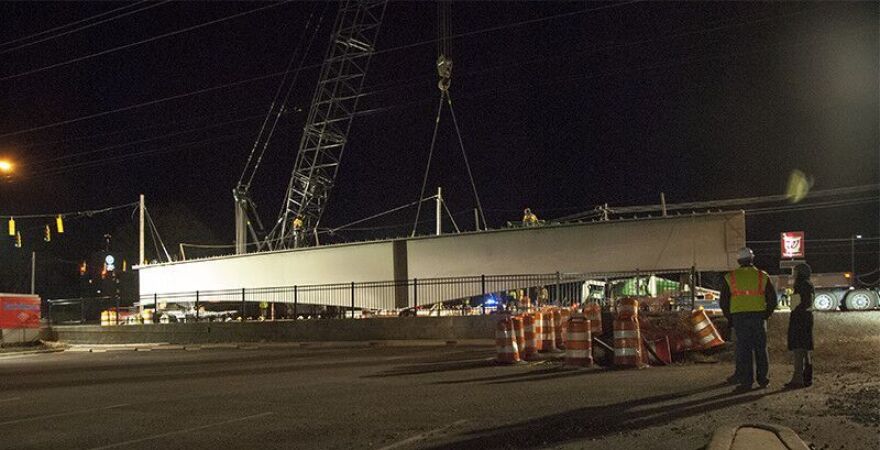Construction of the Charlotte Area Transit System’s Lynx Blue Line northeast extension is hitting another milestone this weekend, with work on a light rail bridge over Harris Boulevard. The project is on track for a mid-2017 opening and already is bringing change to the area.
On Thursday night just before 11 p.m., workers were rigging a 113-foot steel girder onto a crane at North Tryon Street and Harris Boulevard. Over the next week, this and other giant beams will be lifted into in place, completing the final bridge on the Blue Line extension.
“What this bridge will do is it will take light rail vehicles over Harris Boulevard, and separate the trains on the bridge from the cars below,” says David Smith, construction manager for CATS.
Up to now, most work along the 9.3-mile North Tryon corridor has been road-widening and earth moving. It hasn’t really looked like a rail line.
“What you’ll see in the future is you’ll see the rails going down, you’ll see the overhead electrical system that will power the light rail vehicles, and people will start to see, hey, light rail is coming to University City,” he says.
The $1.1 billion extension adds 11 stations from UNC Charlotte to downtown, linking to the existing line from there to I-485 in south Charlotte.
New development already is visible along the line, from the North Davidson street area to the university. Mary Newsom of the UNC Charlotte Urban Institute says change is coming.
“I think over time the whole corridor is going to look completely different. With that said, the part of the corridor that’s closest to uptown is seeing more changes than the part farther out, near UNC Charlotte,” Newsom says.
Dramatic change may not come as easily along the extension as it has south of uptown along the original Blue Line leg. There, most new construction has come on unused industrial land. But NoDa and northeast Charlotte are filled with existing neighborhoods, Newsom says.
“You’re seeing transformation in areas where a lot of people live, currently. Not only where people live, but where people have a lot of warm feelings about NoDa. And as those older buildings are torn down to build new, more highly intense buildings, people are going to get more distressed,” she says.
As work on the final bridge is completed over the next week or so, Harris Boulevard will remain open for all but one crucial task – placing the final girders directly over the road. Officials aren’t yet sure what night that will happen. But CATS spokeswoman Hillary Ryan says most road closings and other disruptions along the line should be done by summer.
Trains should be running by August 2017, construction manager Smith says.



